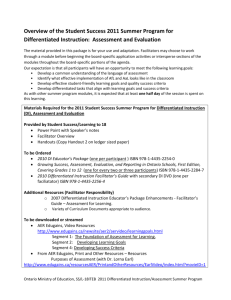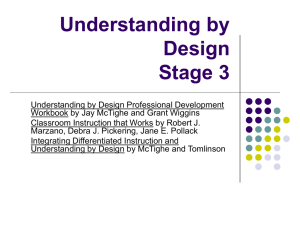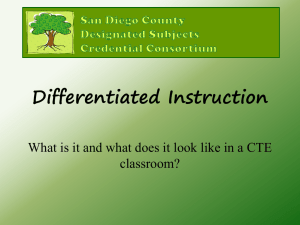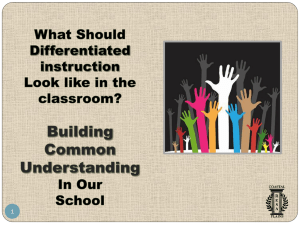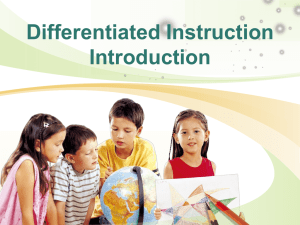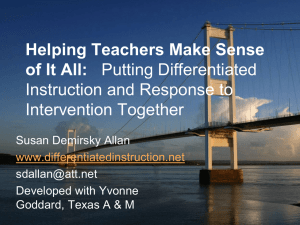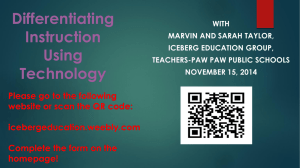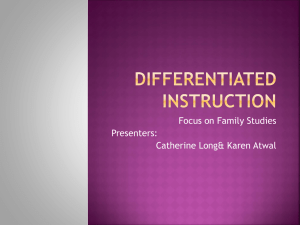PPT - EduGAINS
advertisement
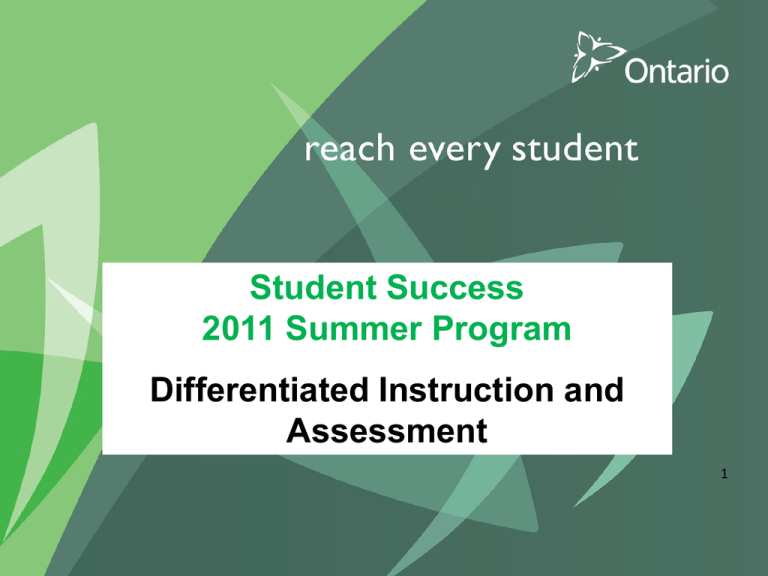
PUT TITLE HERE Student Success Student Success 2011Summer Summer Program 2011 Program Differentiated Instruction and NAME OFAssessment YOUR MODULE HERE 1 Group Profile Knowing the Learner In order to create a group profile, please use sticky dots/markers to indicate on the chart paper: 1. 2. 3. 4. Grade(s) you teach Subject(s) you teach Years of classroom experience with DI Knowledge of assessment for, as, and of learning 2 Differentiated Instruction Professional Learning Strategy, 2011 2 Provincial Context: Core Priorities High Levels of Student Achievement Reducing the Gaps in Student Achievement Increased Public Confidence in Our Publicly Funded Schools 3 School Effectiveness Framework 4 The Professional Learning Cycle 5 5 Student Success Grades 7-12 Strategy PROGRAMS Specialist High Skills Major Dual Credits Expanded Cooperative Education Ontario Skills Passport Board Specific Programs LEADERSHIP DEVELOPMENT • Student Success Leaders • Student Success Teachers • Student Success School and Cross Panel Teams EFFECTIVE INSTRUCTION Differentiated Instruction Math GAINS Literacy GAINS Professional Learning Cycle Student Voice School Effectiveness Framework INTERVENTIONS Credit Rescue / Recovery Transitions Supports/Taking Stock Children and Youth in Care Re-engagement 12 12+Strategy Supervised Alternative Learning 6 School Support Initiative Pyramid of Preventions and Interventions Re-entry to School Program Change In-School Interventions (e.g. ) In-Class Interventions (e.g. ) 7 In-School & In-Class Preventions (e.g. ) Agenda Minds On • Session Purpose, Context and Learning Goals • Knowing the Learner – Group and Table Profiles • Assessment for, as and of Learning Action • • • • • • Connecting DI to Assessment for, as and of Learning Foundation of Assessment for Learning Developing Learning Goals Developing Differentiated Tasks Developing Success Criteria Using Multiple Sources of Evidence Consolidation • Seeing DI and Assessment in Action • Learning Goal Check and Exit Card 8 Session Learning Goals We are learning to: • Develop a common understanding of the language of assessment • Identify what effective implementation of AfL and AaL looks like in the classroom • Develop effective student friendly learning goals and quality success criteria • Develop differentiated tasks that align with learning goals and success criteria 9 Session Handouts Powerpoint Presentation Slide Summary Handout 1: Table Profile Handout 2: Session Placemat Handout 3: Assessment Handout 4: Guided Viewing – Foundation of AfL Handout 5: Concept Attainment – Learning Goals Handout 6: Guided Viewing – Five Strategies 10 Table Profile Create a profile of your table group that includes: • The subject(s) you teach • The grades you teach • A summer highlight • Learner Preference (auditory,visual or kinesthetic) •Years of teaching experience Add your learning style information to the Group Profile on the wall. 11 11 Profiles • Present one or two highlights from your Table Profile to the whole group • Share some experiences about the use student or class profiles 12 Connections Slide Session Learning Goals Assessment for Learning Model DI Framework for Teaching and Learning Planning With the End in Mind Diagram Sources of Evidence Assessment for Learning definition Assessment as Learning definition Assessment of Learning definition 5 Strategies of Assessment for Learning 13 Assessment ‘for’, ‘as’ and ‘of’ Learning Terms such as diagnostic, formative and summative have been supplanted with the phrases assessment for learning, assessment as learning and assessment of learning. Growing Success, 2010, p.30 Discuss why this might be happening. 14 Session Placemat 15 Minds On – Placemat Activity 1 Think Pair Square Individually: • read each of the statements listed under Activity 1 on your Placemat (Side A) • decide whether each statement represents an AfL, AaL, or AofL practice In Pairs, then Fours • Compare your responses with your partner. Where are they the same? Where are they different? 16 Placemat Activity 1 - Debrief • Which statements were difficult to categorize? • What were the criteria you used to make your decisions? • What is it that determines whether an assessment is for as or of learning? 17 Common Understanding What are: • Assessment for learning • Assessment as Learning • Assessment of Learning 18 Differentiated Consolidation Assessment ‘for’, ‘as’ and ‘of’ Learning 1. Select one of the following options to consolidate your understanding of Assessment ‘for’, ‘as’ and ‘of’ Learning: • • • • View Dr. Lorna Earl Video Read Handout 3 - Assessment Read pp. 28-31 Growing Success Read pp 15-17 2010 DI Educator’s Guide 2. Join with others who have selected the same option. 3. After viewing or reading, discuss with your group and create a statement that summarizes your key learning. 4. Share with other groups. 19 Dr. Lorna Earl on Assessment http://www.edugains.ca/reso urcesAER/PrintandOtherReso urces/EarlVideo/index.html? movieID=1 20 Agenda Minds On • Session Purpose, Context and Learning Goals • Knowing the Learner – Group and Table Profiles • Assessment for, as and of Learning -Think Pair Square Action • • • • • • Connecting DI to Assessment for, as and of Learning Foundation of Assessment for Learning Developing Learning Goals Developing Differentiated Tasks Developing Success Criteria Using Multiple Sources of Evidence Consolidation • Seeing DI and Assessment in Action • Learning Goal Check and Exit Card 21 Assessment Centres- DI Connection 1. Select the centre of interest to you: - Assessment for learning - Assessment as learning - Assessment of learning 2. At the Centre: a) Complete Placemat Activity 2 as a group (Use Growing Success, page 31 as a reference) b) Prepare to present your work to the whole group 22 PLACEMAT Activity 2 Assessment For Learning Assessment As Assessment Of Learning Learning Who is the active partner? What is the information used for? How does the information contribute to differentiated instruction & assessment? 23 Assessment (See Growing Success p. 31 For Learning As Learning Of Learning By teachers •to determine what to do next instructionally (strategies, differentiation) By student •to determine what to do next in learning (e.g., strategy, focus) By teachers •to determine student’s level of achievement of overall expectations at a given point in time •To provide descriptive feedback to students (what they are doing well, what needs improvement and how to improve) •To provide descriptive feedback to peers and self (peer and self assessment) •to become reflective, selfmonitoring learner •As evidence to support professional judgment •To provide information about where students are in relation to learning goals (i.e., readiness) to inform differentiated instruction •To guide (student) choice of options for learning and demonstrating learning (e.g., interests, learning preferences, readiness) •To provide information about student achievement and their level of readiness for next steps (as well as 24 their interests and learning preferences) •Assessments can vary in structure (conversations, observations, products) and can be differentiated. Video: Foundation of Assessment for Learning How are teachers supporting students in monitoring and directing their own learning? Use the Video Viewing Guide handout to take notes as you watch the video. •What do you see? •What do you think about that? •What does it make you wonder? 25 Video: Foundation of Assessment for Learning. Hattie and Timperley (2007 ) describe three questions that guide learning for students: • Where am I going? • How am I going? • Where to next? 26 Assessment for Learning Success Criteria Descriptive Feedback Peer- and Self-Assessment Individual Goal Setting Gathering Information About Student’s Understanding Engineering effective conversations, questions, and learning tasks Learning Goals 27 Video: Foundation of Assessment for Learning DISCUSSION 1. How are teachers empowering students to monitor and direct their own learning? 2.Video prompts: • What do you see? • What do you think about that? • What does it make you wonder? 28 Growing Success Cross Check Table Groups 1.Each table member or pair selects one Growing Success section to read: – – – – An Assessment Framework – (p. 32, Growing Success) Developing Learning Goals and Identifying Success Criteria – (p. 33, Growing Success) Eliciting Information and Providing Descriptive Feedback (p. 34, Growing Success) Developing Student Self-Assessment and Peer-Assessment Skills and Developing Individual Goal Setting – (p. 35, Growing Success) 2.Note any additional ideas in the last column of the Viewing Guide. 3.Share with the Table Group. 29 DI Connection • • How does identifying, sharing, and clarifying learning goals and success criteria lead to the development of respectful differentiated tasks? How do learning goals and success criteria help teachers differentiate : – – – an entry point for learning? the way students learn? the way students demonstrate their learning? 30 Video: Developing Learning Goals Before Viewing • As a table group, complete the Concept Attainment Activity for Effective Learning Goals During Viewing • Add to the ‘success criteria’ for effective learning goals - the 3rd column After Viewing • Consolidate the criteria for effective learning goals 31 Before Viewing As a table group, • discuss and complete the Concept Attainment activity for effective learning goals HANDOUT 5 32 During Viewing Video: Developing Learning Goals What are the ‘criteria’ for writing effective learning goals? (Note in 3rd column) HANDOUT 5 33 After Viewing Video: Developing Learning Goals Table Groups • share the ‘criteria’ added in column 3 during the video. • Consolidate and refine responses HANDOUT 5 34 Developing Learning Goals Applying the Criteria In Like-Subject and/or Grade groups Choose an overall expectation and: • Create a learning goal from the overall expectation • Consider the specific expectations support that overall expectation and use them to develop incremental learning goals SEE PLACEMAT ACTIVITY 3. • Ensure that the learning goals meet the criteria established in the previous activity 35 36 Differentiating Assessment Subject Pairs or Triads 1. Based on your learning goals, think about and briefly describe a strategy or task that provides information for: • assessment as, for learning SEE PLACEMAT ACTIVITY 3. and/or • assessment of learning. 2. Describe how this strategy/task can be differentiated based on (a) student interests, (b) learning preferences and/or (c) readiness 37 For example . . . SEE PLACEMAT ACTIVITY 3. Task - Journal Entry- assessment for learning • Differentiated by interest – offer choice of topics • Differentiated by learning preferences – offer a choice of hand held recorder, conference or written format • Differentiated by readiness – provide support such as sentence starters or key questions to guide thinking for some students Differentiating Assessment Subject Pairs or Triads 1. Share with another like or related subject group. 2. Provide each other descriptive feedback on the extent to which the differentiated strategies/tasks align with the learning goals. 3. Refine based on feedback 4. Be prepared to share with large group SEE PLACEMAT ACTIVITY 3. 39 Video – Success Criteria Subject Groups During Viewing: 1. All - track strategies that are used to establish and create Success Criteria 2. Individuals, select a question (below) to think about and respond to after viewing. (Ensure that all questions are covered by the group.) Focus Questions • What are success criteria, and how are they used by teachers or students in assessment for learning, assessment as learning, and assessment of learning? • Why is it so important that students be engaged in the development of success criteria? • How are success criteria linked to learning goals, descriptive feedback, 40 rubrics, and self-assessment? Success Criteria Subject Pairs or Triads 1. Develop success criteria for the previously developed learning goals. 2. Examine each of the differentiated strategies/tasks to see if they provide opportunities to demonstrate the success criteria related to the learning goals. Refine strategies/tasks as needed. 3. Be prepared to share your observations with the large group. SEE PLACEMAT ACTIVITY 3. 41 How do you know your students are learning? 1. List all the ways you know your students are learning. 2. Which ways provide information for assessment as/for learning? of learning? 3. Write one way per stickynote – use three colours; one for as learning, one for for and one for of learning. 42 Triangulation =Valid and Reliable Categorize each “way”according to its most likely source(s). Conversations Post your “ways” at the appropriate spot on the wall chart. Observations Products 43 Triangulation •Which sources of evidence are most used? Conversations •Which colour of sticky is most evident? •What does this tell us about our current practice? •How do we become more balanced? Observations Products 44 Sources of Evidence Conversations Running Record List of Books Read Vocabulary Checklists Notes from Literature Circle Observation Checklist Processfolio Anecdotal observation Questioning Presentations Listening Speaking Problem Solving Group Skills Observations Conferences Notes Journal Blogs Moderated Wikis Moderated Online forums Student feedback Focused conversations Portfolio Conferencing Performance Tasks Assignments Test Scores Reader Responses Tests Portfolios Checklists Videos Journals Projects Graphs Tests Products 45 Making Connections Sources of Evidence Subject Pairs or Triads 1. Your previously developed strategies/tasks provide evidence of student learning from which source(s) - conversations, observations and/or products? 2. In what other ways could you use conversations, observations and/or products to gather information about student progress towards the learning goals? SEE PLACEMAT ACTIVITY 3. 46 Sources of Evidence Subject Pairs or Triads Select one of these ‘ways’ - a strategy or task (for a conversation, an observation or a product ) to differentiate based on student • interests • learning preferences/strengths, or • readiness. SEE PLACEMAT ACTIVITY 3. 47 How do we make it happen? TEACHER What are students expected to learn? STUDENT Overall and Specific Expectations Learning Goals How will students demonstrate their learning? Conversations Observations Products Success Criteria Saying, Writing, Doing How will we design the learning so all will learn? Differentiated Instruction & Assessment Strategies/Tasks Descriptive Feedback Peer & Self- Assessment Goal Setting 48 Reflection Table Groups • As a table group, reflect on how the elements on the previous slide connect with Placemat activity 3. • Be prepared to share a comment or question with the full group. “Learning without reflecting is like eating without digesting.” Anne Davies 49 Agenda Minds On • Session Purpose, Context and Learning Goals • Knowing the Learner – Group and Table Profiles • Assessment for, as and of Learning -Think Pair Square Action • • • • • • Connecting DI to Assessment for, as and of Learning Foundation of Assessment for Learning Developing Learning Goals Developing Differentiated Tasks Developing Success Criteria Using Multiple Sources of Evidence Consolidation • Seeing DI and Assessment in Action • Learning Goal Check and Exit Card 50 Assessment for Learning and as Learning Five strategies that support student learning: 1. identifying and clarifying learning goals and success criteria; 2. engineering effective classroom discussions and other learning tasks that elicit information about student learning; 3. providing feedback that helps learners move forward; 4. through targeted instruction and guidance, engaging students as learning resources for one another 5. through targeted instruction and guidance, helping students understand what it means to “own” their own learning, and empowering them to do so - Adapted: from Black and Wiliam (2009) as cited in Growing Success 51 Consolidation - Video Table Groups • Examine the Five Strategies on Handout 6. • Watch the video and note connections to the Five Strategies. • Share within the table group; be prepared to share with the large group. 52 Consolidation We are learning to: • Develop a common understanding of the language of assessment • Identify what effective implementation of AfL and AaL looks like in the classroom • Develop effective student friendly learning goals and quality success criteria, • Develop differentiated tasks that align with learning goals and success criteria 53 Reflection - Exit Card Table Groups: (1 large sticky note or index card per table) • Examine the session learning goals and identify ‘what you (now) know and can do’ for two of more of the goals. • Identify one or more areas for further learning. • Hand in to your facilitator. 54 Contacts For additional information please contact: John.piper@ontario.ca anne.clifton@ontario.ca karen.greenham@ontario.ca 55 •55 Supplementary Slides • The slides after this point are here as reference points for the presentation and the facilitator. 56 Assessment for Learning The ongoing process of gathering and interpreting evidence about student learning for the purpose of determining where students are in their learning, where they need to go, and how best to get there. (p. 144) 57 57 Assessment as Learning The process of developing and supporting student metacognition. Students are actively engaged in the assessment process; that is, they monitor their own learning, use assessment feedback form teacher, self and peers to determine next steps; and set individual learning goals. (Growing Success, p. 143) 58 Assessment of Learning The process of collecting and interpreting evidence for the purpose of summarizing learning at a given point in time, to make judgements about the quality of student learning on the basis of established criteria, and to assign a value to represent that quality. The information gathered may be used to communicate the student’s achievement to parents, other teachers, students themselves, and others. It occurs at or near the end of a learning cycle. (p. 144) 59 Assessment for Learning and as Learning As essential steps in assessment for learning and as learning, teachers need to: – plan assessment concurrently and integrate it seamlessly with instruction; – share learning goals and success criteria with students at the outset of learning to ensure that students and teachers have a common and shared understanding of these goals and criteria as learning progresses; – gather information about student learning before, during, and at or near the end of a period of instruction, using a variety of assessment strategies and tools; – use assessment to inform instruction, guide next steps, and help students monitor their progress towards achieving their learning goals; 60 ...cont’d Assessment for Learning and as Learning • analyse and interpret evidence of learning; • give and receive specific and timely descriptive feedback about student learning; • help students to develop skills of peer and self-assessment. 61 Professional Judgement: Determining a Grade To determine a student’s report card grade, teachers will consider: • all evidence collected from a variety of sources through observations, conversations, and student products; • the evidence for all the tests/exams and assignments for evaluation that the student has completed or submitted; • the number of tests/exams or assignments for evaluation that the student did not complete or submit; • the different weights assigned to various pieces of 62 evidence.

